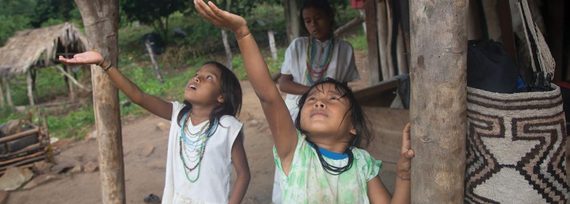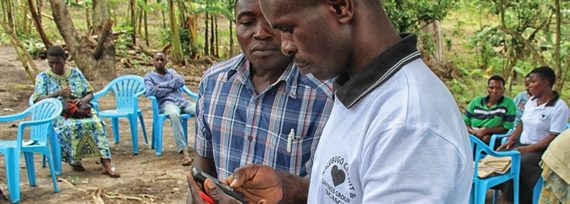Each year, Lutheran World Relief's Early Warning Forecast singles out seven continuing or potential hot spots that may require humanitarian -- and in some cases diplomatic -- action in the next year.
But as an organization that draws inspiration from faith, we always embrace and maintain hope. We can clearly see that significant progress is being made in reducing global suffering and poverty. For example, as measured by the Millennium Development Goals, the number of people living in extreme poverty and under-age-5 mortality has fallen by more than half. Continuing that work, the world community has adopted a set of Sustainable Development Goals that are truly aspirational, including reaching a statistical "zero" on extreme poverty, preventable child deaths and other targets.
In that spirit, here are 3 signs of hope that we see in 2017.
1. Building Peace in Colombia
What We're Seeing
The advent of peace in Colombia will bring an end to five decades of armed conflict that has DISPLACED NEARLY 6 MILLION PEOPLE. After a first peace accord failed to win public approval at referendum, the government and the main rebel group reached a new agreement in November that preserves the promise of peace in Colombia. And with peace comes tremendous opportunity. With almost a third of Colombia's population living in rural areas of the country, Colombia must address its "new rural reality" as part of the post-peace process. The effort presents a chance to tackle some of the most important root causes of the conflict and offers the best way to attain a lasting peace.
What We're Doing
LWR is committed to advancing the dignified, safe and sustainable rural return and relocation for Colombia's internally displaced people as the country emerges from five decades of civil conflict. LWR has worked in Colombia since the late 1990s, supporting cooperatives and rural populations, including Afro-Colombian and indigenous communities, to help increase their incomes and claim their rights under the Victims and Land Restitution Laws. LWR has been an active participant in the peace process at the highest levels, offering counsel and support. Our current focus builds on this work to promote innovative programs with the private sector, which link the promise of peace to family food security in former conflict areas.
To achieve this, LWR works primarily with local NGOs, farming communities, Afro-Colombian community councils and indigenous governments to implement projects that strengthen the social fabric of communities weakened by violence, stimulate agricultural production (particularly in coffee and cocoa) for increased food security and higher incomes, and improve water systems.
2. The Promise of Information Communications Technology
What We're Seeing
Information communications technologies -- powerful, yet accessible tools such as mobile phones, laptop computers, the internet, radio and other technologies -- allow people to more easily connect with each other. These technologies are becoming increasingly accessible in the developing world, as noted in a recent Pew Research Center survey that characterized cell phone usage in sub-Saharan Africa as
pervasive (two-thirds or more of those surveyed across the continent said they owned a cell phone). And these mobile and internet technologies aren't just being used for simple text messages, emails and calls, but also for an increasing array of activities and services such as banking, knowledge sharing and education. These instruments of ICT4D (Information Communications Technology for Development) are increasingly being used as powerful tools in development. They can be used to share important information, helping farmers to increase agricultural productivity, aiding in the protection of the environment and facilitating the collection of vital information in disaster situations.
What We're Doing
LWR uses ICT4D extensively in projects around the world, such as conveying agricultural information to farmers in our Mobile Cocoa initiative in Nicaragua; using mobile banking with savings groups in Uganda; and collecting disaster data on tablets in the Philippines. The use of ICT4D enhances relief and development programs because it:
- Provides a cost-effective way to deliver agricultural extension services to farmers living in isolated communities;
- Offers a potent way to access financial and credit services, and manage money in a rural economy, where few banks exist;
- Allows producers a way to quickly and directly obtain accurate weather and market information, improving production and ensuring best commodity prices.
3. African Economic Growth: Good and Bad News
What We're Seeing
Currently, there are what could be called two Africas, growing at different rates. Between 2000 and 2010, the GDP in Africa grew by an annual average of 5.4 percent, making it one of the fastest growing regional economies in the world. But recent years have seen a slowdown, with average GDP growing by 3.3% between 2010 and 2015. And the International Monetary Fund recently downgraded its 2016 forecast for growth in sub-Saharan Africa to 1.4 percent. This is a classic good news/bad news scenario. The bad news: economic growth in some countries has declined sharply, due in large part to the steep drop in commodity prices. Countries with economies dependent on commodities like oil, including Nigeria and Angola, have seen their growth plummet. The good news: countries with more diverse portfolios are continuing to thrive. Ivory Coast was on track for a growth rate of 8 percent in 2016; East African nations were also humming along, with Ethiopia's projected growth at 8.1 percent, Tanzania at 7.2 percent, Kenya at 6 percent and Uganda at 5.1 percent. The cloud hanging over this positive economic trend is that growth within these countries has failed to be equal and inclusive, with some sectors benefiting as large swaths of society are left out.
What We're Doing
LWR works to provide the rural poor with greater access to global and regional markets. By investing resources into improved practices for growing, processing and storing their harvests, farmers can increase the quantity and quality of their crops. These benefits are multiplied when farmers work together through farmer organizations, which can help access financial services and negotiate with buyers for better crop prices. At the household level, diversifying the crops farmers grow, as well as increasing sources of income, will increase resilience to economic downturns or other adversity.



